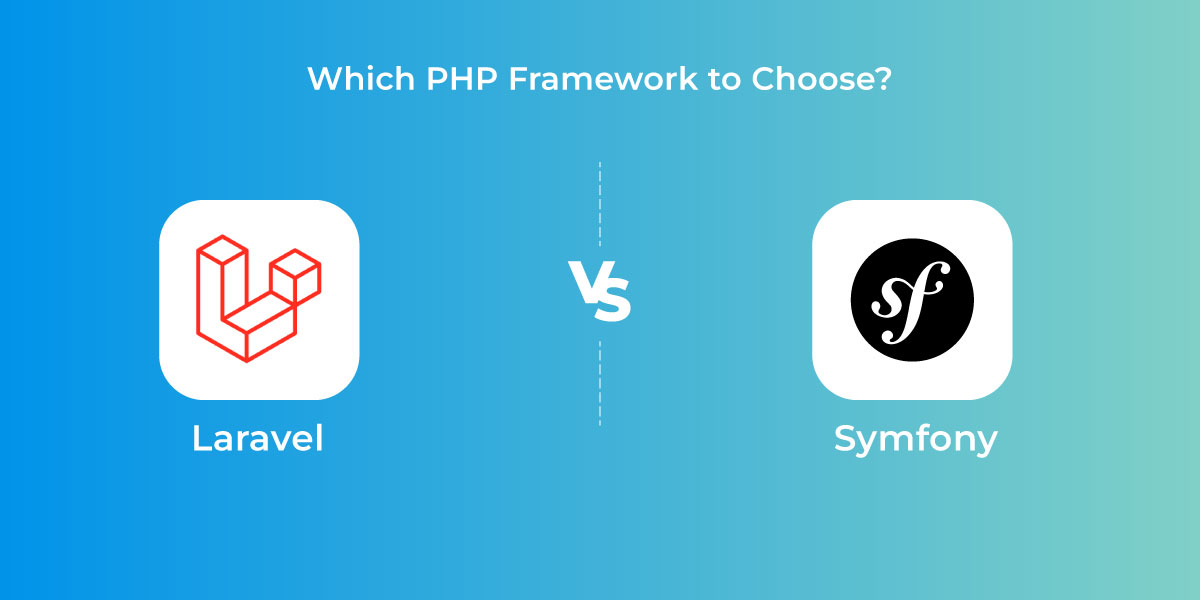Table Of Content:
- Introduction
- Laravel:
- What is Laravel?
- Features Of Laravel
- Pros and Cons Of Laravel
- Symfony:
- What is Symfony?
- Features Of Symfony
- Pros and Cons Of Symfony
- Similarities Between Laravel & Symfony
- Laravel VS Symfony: In-Depth Comparison
- Installing and setting up Laravel and Symfony
- Framework Configurations for Laravel and Symfony
- Routing & configuration
- Templates
- Dependency Injection
- Conclusion
Web application development has grown in popularity over the years, with several frameworks developing to assist developers in creating fast, scalable, and secure web applications.
Laravel vs Symfony: Two prominent PHP frameworks used by developers all around the world.
As a developer, selecting the proper framework for your project is critical since it may have a significant influence on your development process and ultimate result. We will compare the Laravel and Symfony frameworks in this blog article, highlighting their differences, similarities, strengths, and flaws.
By the end of this post, you will have a better understanding of which framework to choose based on your project’s requirements.
What is Laravel?
Laravel is a free and open-source PHP web application framework created by Taylor Otwell in 2011. Laravel follows the Model-View-Controller (MVC) architectural pattern, making it easy for developers to build scalable, maintainable, and efficient web applications. Laravel is known for its elegant syntax, robust features, and ease of use, making it a popular choice among PHP developers.
Features of Laravel:
Laravel comes with a wide range of features that simplify the development process and make it easier for developers to build web applications. Some of the key features of Laravel include:
- Blade Templating Engine: Laravel comes with a powerful templating engine called Blade, which allows developers to write clean and concise templates for their views.
- Eloquent ORM: Laravel’s Eloquent ORM (Object Relational Mapping) provides an intuitive way for developers to work with databases, making it easier to perform CRUD (Create, Read, Update, and Delete) operations.
- Artisan Command Line Interface: Laravel’s command-line interface, Artisan, provides a set of helpful commands for performing common tasks, such as generating boilerplate code, running database migrations, and more.
- Security: Laravel has built-in security features, such as protection against SQL injection, cross-site scripting (XSS) attacks, and more.
Pros & Cons Of Laravel:
Pros:
- Laravel is easy to learn and use, making it a great choice for beginners.
- Laravel has a large and active community, which means there are plenty of resources and tutorials available online.
- Laravel comes with a wide range of features and tools, making it easy for developers to build complex web applications.
- Laravel is highly customizable, allowing developers to create applications that meet their specific requirements.
Cons:
- Laravel’s performance can be slower compared to other frameworks due to its heavy use of abstractions and its reliance on the file system for some tasks.
- Laravel’s extensive feature set can sometimes lead to complexity, which may make it more difficult to maintain large applications.
- Laravel’s documentation can be incomplete or outdated, which can be frustrating for developers trying to learn the framework.
Develop your next Laravel application with 7Technosoft Solutions
Hire Laravel Developer 7Technosoft Solutions is an emerging Laravel development company in India. We develop high-quality web applications using the Laravel framework. Our team uses cutting-edge technologies to provide maximum value for our clients.
What is Symfony?
Symfony is also a well-known PHP-based web framework that was initially launched in the year 2005 by Fabien Potencier. This framework is created above on the Components project, which caters to reusable PHP libraries which are highly important for building web-based cloud applications. Symfony also follows the (MVC) architecture and is known for its modularity and extensibility.
Symfony Features:
Being a competitor of Laravel, Symfony offers a great range of features that helps in simplifying the web development journey and making it a lot easier for web developers to build online cloud applications. Following are some of the major features that you might want to consider while choosing Symfony:
- Twig Templating Engine: Symfony uses the Twig templating engine, which is fast, secure, and highly extensible.
- Doctrine ORM: Symfony’s Doctrine ORM provides a powerful way for developers to work with databases, making it easy to perform CRUD operations and more complex queries.
- Command Line Interface: Symfony’s command-line interface, Console, provides a set of helpful commands for performing common tasks, such as generating boilerplate code, running database migrations, and more.
- Command Line Interface: Symfony’s command-line interface, Console, provides a set of helpful commands for performing common tasks, such as generating boilerplate code, running database migrations, and more.
Pros & Cons Of Symfony:
Pros:
- Symfony is highly modular and extensible, making it a great choice for building large-scale web applications.
- Symfony has a large and active community, which means there are plenty of resources and tutorials available online.
- Symfony is highly customizable, allowing developers to create applications that meet their specific requirements.
- Symfony has excellent documentation that is regularly updated and maintained.
Cons:
- Symfony has a steeper learning curve compared to other PHP frameworks, which may make it more difficult for beginners to learn.
- Symfony’s extensive configuration files and directory structure can sometimes lead to complexity, which may make it more difficult to maintain large applications.
- Symfony’s performance can sometimes be slower compared to other frameworks due to its reliance on configuration files and other abstractions.
Similarities between Laravel & Symfony:
Laravel and Symfony share many similarities with PHP frameworks. Firstly, both are open-source projects and are based on the Model-View-Controller (MVC) pattern, meaning that they share similar conceptual structures and approaches to building web applications.
Secondly, they both offer a Command Line Interface (CLI) tool for common tasks, which can greatly simplify development workflows.
Thirdly, both frameworks organize code in a particular way, which enhances code readability and maintainability.
Fourthly, both offer testing tools, which help developers ensure code quality and prevent errors. Additionally, Laravel and Symfony leverage existing projects, such as Object-Relational Mappers (ORMs) and Template Engines, to cover the full stack of web development.
Furthermore, they can be run on multiple platforms and have built-in internationalization features, which enable web applications to be deployed across different operating systems and database engines while supporting multiple languages. Finally, both frameworks are designed to be easily extended, making them highly customizable to fit different project needs.
Discover why Laravel is the PHP framework that reigns supreme – and is the perfect fit for your next web development project!
Laravel VS Symfony:
| Variables | Laravel | Symfony |
| Framework | MVC architecture | MVC architecture |
| Scalability | Highly scalable | Highly scalable |
| Support | Large and active community | Large and active community |
| Learning curve | Easy to learn | Steeper learning curve |
| Processing speed | Slower compared to some frameworks | Can be slower due to abstractions |
| Design features | Elegant syntax, intuitive Eloquent ORM, Blade Templating Engine | Twig Templating Engine, Doctrine ORM |
| Maintenance | Easy to maintain | Can be complex for large applications |
| Integration | Highly integrable | Highly integrable |
| Security | Built-in security features | Robust security system |
| Installation procedure | Easy and straightforward | Easy and straightforward |
| Performance | Good performance | Good performance |
| Testing | Has built-in testing support | Has built-in testing support |
| Popularity | Very popular | Very popular |
Installing and setting up Laravel and Symfony:
Both Laravel and Symfony have very simple installation procedures. Laravel may be installed with Composer, a PHP dependency management that makes it simple to manage and maintain package dependencies up to current. After installing Composer, Laravel can be installed with a single command.
Similarly, Symfony may be installed via Composer, which is the recommended method of doing so. Symfony also has a web-based installer that can walk developers through the installation process and help them tailor it to their specific needs. Overall, both frameworks provide basic and intuitive installation methods that are quick and easy to accomplish.
Framework Configurations for Laravel vs Symfony:
Both Laravel and Symfony offer customizable setups that may be tailored to suit projects’ needs. Configuration files in Laravel are saved in the config directory and may be updated to modify the framework’s functionality. Developers, for example, can alter configuration files to alter database settings, caching techniques, or session management. Moreover, Laravel has a robust environment configuration system that enables developers to create various parameters for different contexts (such as development, staging, and production).
Similarly, Symfony provides a solid configuration mechanism based on a collection of YAML files. These files explain how various framework components, including as routing, security, and services, should act. The configuration files are structured hierarchically, allowing developers to change or enhance current configuration settings. Moreover, Symfony has a robust Dependency Injection (DI) component that allows developers to specify and manage object dependencies throughout the application.
Symfony offers a versatile application configuration mechanism that enables developers to generate various configuration files for different situations. This eliminates the need to explicitly integrate sophisticated PHP code into YAML configuration files. If, on the other hand, you like the normal PHP configuration syntax used by Laravel, you may utilize it instead of learning Symfony’s YAML grammar.
Routing and configuration:
The routes/web.php file in Laravel handles routing by defining the application’s HTTP routes. URL patterns can be defined by developers, associated with certain HTTP methods, and routed to controllers. Controllers are PHP classes that manage HTTP requests, and they may access and alter data from models, views, and services.
The config/routes.yaml file in Symfony handles routing by defining the application’s routes in YAML format. URL patterns can be defined by developers, associated with certain HTTP methods, and routed to controllers. Controllers in Symfony are PHP classes that manage HTTP requests and may access and alter data from models, views, and services.
Templates:
Both Laravel and Symfony provide a templating system that allows developers to isolate their application’s display layer from its business logic.
Blade is the default templating engine in Laravel. It provides a simple yet powerful syntax for developers to construct clean and reusable templates. Blade templates provide control structures, template inheritance, and custom directives, and they may be expanded and reused across the application.
Twig is the default templating engine for Symfony. It is a contemporary, versatile, and safe templating engine with many capabilities such as template inheritance, control structures, macros, and filters. Twig templates are well-organized and simple to use, making them perfect for developing sophisticated web applications.
Because Blade and Twig are both extensively used and have active communities, developers may quickly obtain documentation, tutorials, and packages to increase their capability. Ultimately, both Laravel vs Symfony provide strong and simple templating systems that allow developers to construct visually appealing and maintainable online applications.
Dependency Injection:
Dependency Injection is a design pattern that allows developers to construct loosely connected, reusable, and testable code by abstracting the burden for establishing and managing dependencies away from the classes themselves. Dependency Injection is supported by both Laravel vs Symfony out of the box.
The Laravel Service Container, a robust and versatile container that controls the instantiation and resolution of classes and their dependencies, handles Dependency Injection in Laravel. Developers may describe their dependencies in the Service Container, and Laravel will resolve them automatically when necessary. This makes swapping out implementations and writing unit tests a breeze.
On the other hand, Dependency Injection is handled by the Symfony Dependency Injection Component, which is a standalone container that manages the instantiation and resolution of classes and their dependencies, which is a standalone container that manages the instantiation and resolution of classes and their dependencies. Developers may describe their dependencies in the container configuration files, and Symfony will resolve them automatically when necessary. This also makes swapping out implementations and writing unit tests simple.
Both Laravel VS Symfony provides sophisticated techniques for managing dependencies and enhancing code maintainability when it comes to Dependency Injection. The Dependency Injection system in Laravel features a highly straightforward autodetection capability that requires no additional configuration and allows developers to concentrate on application logic.
Symfony has a functionality similar to this called “autowire,” which is disabled by default and takes some additional settings to enable. While both systems provide tremendous features, Laravel’s approach is often regarded as simpler and more basic, making it a popular choice among developers seeking to avoid configuration overhead and get up and running quickly. Nevertheless, the best decision between Laravel and Symfony’s Dependency Injection systems ultimately depends on the project’s and development team’s individual needs and preferences.
Conclusion:
Finally, the decision between Laravel and Symfony is heavily influenced by the unique demands and goals of your project. Laravel is an excellent choice for novices searching for a user-friendly and simple-to-learn framework, as well as entrepreneurs needing to swiftly construct and test a product.
Symfony, on the other hand, is a good solution for sophisticated business applications and long-term projects requiring high scalability, maintainability, and predictability. Finally, both frameworks have advantages and disadvantages, and the optimal decision is determined by the project’s and development team’s unique needs and preferences.
How do the development communities for Laravel and Symfony differ, and which one might be better suited for my project needs?
With a focus on current web development standards, the Laravel community is regarded for being incredibly active and helpful. The Symfony community is likewise quite active, although it focuses on corporate applications.
Which framework is better for developing complex web applications: Laravel or Symfony?
Laravel and Symfony are both capable of creating sophisticated web apps. Personal taste, project needs, and the developer’s skill set all influence the decision.
I have an existing web application built on one framework, can I switch to the other framework without any major issues or data loss?
Switching from Laravel and Symfony is doable, although there may be some compatibility concerns and data loss. Before making the transfer, it is suggested that you talk with a competent developer.
What are some popular web applications that have been built using Laravel and Symfony respectively?
Laravel Forge, Laravel Spark, and OctoberCMS are examples of popular web applications created with Laravel. Drupal, phpBB, and eZ Publish are examples of popular online applications created with Symfony.
Do you offer development services for both Laravel and Symfony, and how can I get in touch with you to discuss my project requirements?
Yes, we provide Laravel and Symfony development services. To discuss your project needs, please contact us via our website or by email.
What is your laravel development life cycle or journey?
The requirements gathering, design and planning, coding and implementation, testing and debugging, and deployment and maintenance phases of our Laravel development life cycle are all included. We use an agile development methodology that provides for flexibility and modification throughout the project.







